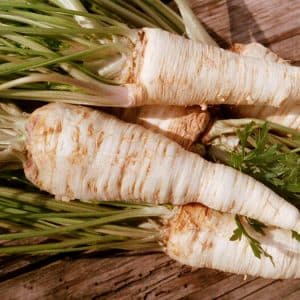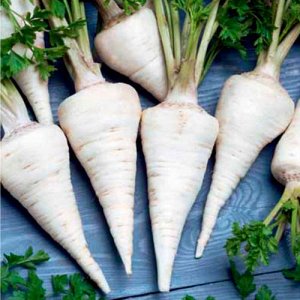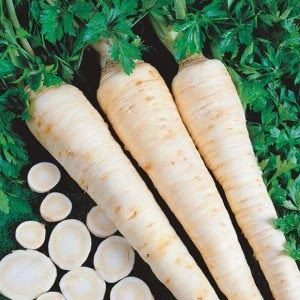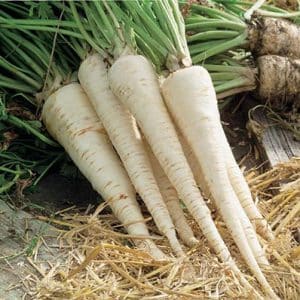What is good about root parsley and why it is worth growing it
Root parsley is a spicy plant that has long become a regular guest on our table. The root vegetable contains more vitamin C than lemons and more vitamin A than carrots.
The culture is unpretentious in growing and with proper care produces a rich harvest. The roots are widely used in folk medicine and cooking, and are prepared for the winter by freezing and drying.
Description and characteristics of root parsley
Root parsley is a biennial plant from the Apiaceae family, genus Parsley. The above-ground part is represented by dark green, smooth, fragrant foliage of a strongly dissected shape, slightly harsh compared to leaf parsley. The erect stem is prone to branching and reaches 1 m in height.
The root is conical, spindle-shaped, white or creamy-gray in color. The length depends on the variety and varies between 18-30 cm. The weight of the root crop is from 30 to 300 g.
The plant enters the flowering period in June-July. The flowers are small, yellow with a greenish tint.
In the first year it produces a harvest of greens and root crops. In the second year, seeds are collected.
It grows wild on rocky soils, mountain slopes, and near water bodies. The photo shows parsley root.
Historical reference. The ancient Egyptians believed that parsley came from the blood of the murdered son of the god Osiris. Greenery was used as ritual paraphernalia - they wove wreaths and put them on their heads.
Chemical composition
The table shows a set of vitamins and minerals per 100 g of product.
| Name | Content | Norm |
| Vitamin A | 2 mcg | 900 mcg |
| Beta carotene | 0.01 mg | 5 mg |
| Vitamin B1 | 0.08 mg | 1.5 mg |
| Vitamin B2 | 0.1 mg | 1.8 mg |
| Vitamin B4 | 7.7 mg | 500 mg |
| Vitamin B5 | 0.4 mg | 5 mg |
| Vitamin B6 | 0.6 mg | 2 mg |
| Vitamin B9 | 24 mcg | 400 mcg |
| Vitamin C | 35 mg | 90 mg |
| Vitamin E | 0.1 mg | 15 mg |
| Vitamin K | 164 mcg | 120 mcg |
| Vitamin PP | 1.3 mg | 20 mg |
| Niacin | 1 mg | — |
| Potassium | 342 mg | 2500 mg |
| Calcium | 57 mg | 1000 mg |
| Silicon | 13 mg | 30 mg |
| Magnesium | 22 mg | 400 mg |
| Sodium | 8 mg | 1300 mg |
| Sulfur | 22.3 mg | 1000 mg |
| Phosphorus | 73 mg | 800 mg |
| Chlorine | 18.8 mg | 2300 mg |
| Aluminum | 97.4 mcg | — |
| Bor | 41 mcg | — |
| Vanadium | 10 mcg | — |
| Iron | 0.7 mg | 18 mg |
| Iodine | 0.1 mcg | 150 mcg |
| Cobalt | 1.38 mcg | 10 mcg |
| Lithium | 2.8 mcg | — |
| Manganese | 0.42 mg | 2 mg |
| Copper | 220 mcg | 1000 mcg |
| Molybdenum | 2.9 mcg | 70 mcg |
| Nickel | 11.1 mcg | — |
| Rubidium | 14.2 mcg | — |
| Selenium | 0.1 mcg | 55 mcg |
| Fluorine | 110 mcg | 4000 mcg |
| Chromium | 2.8 mcg | 50 mcg |
| Zinc | 1.3 mg | 12 mg |
KBZHU
Nutritional value of parsley root:
- calorie content - 51 kcal;
- proteins - 1.5 g;
- fats - 0.6 g;
- carbohydrates - 10.1 g;
- dietary fiber - 3.2 g;
- water – 83 g;
- ash - 1.5 g.
Beneficial features
Parsley root has a whole range of beneficial properties:
- assistance in the treatment of scarlet fever and measles;

- normalization of sexual function in men: the plant is a powerful aphrodisiac;
- normalization of digestion;
- removing excess fluid from tissues;
- blood purification;
- diuretic effect;
- normalization of blood sugar levels;
- reduction of symptoms of allergic reactions;
- prevention of diseases of the cardiovascular system;
- maintaining visual acuity;
- acceleration of wound healing in the oral cavity;
- getting rid of bad breath;
- prevention of the development of osteoporosis;
- increasing immunity;
- elimination of freckles and age spots.
The best varieties
The table shows the most popular varieties of root parsley.
| Name | Ripening period | Root shape | Length, cm | Weight, g | Coloring |
| Sugar | 95-100 days | Conical, pointed | 25-30 | 100-110 | Gray-white |
| Harvest | 128-130 days | Conical, pointed | 20-22 cm | 90-100 | Gray-white |
| Bordovikskaya | 130-135 days | Elongated, cylindrical | 30-35 | 150-170 | Gray-white |
| Berlin | 150-180 days | Cone-shaped, pointed | 20-25 | 100-120 | Gray-white |
| Alba | 160-180 days | Cone-shaped, pointed | 50-60 | 220-290 | Cream |
| The final | 130-135 days | Conical, pointed | 20-23 | 150-190 | Gray-white |
| Eagle | 130-135 days | Cone-shaped | 25-30 | 130-140 | Gray-white |
| Good morning | 125-130 days | Cone-shaped, pointed | 20-23 | 100-120 | White |
Features of agricultural technology
Root parsley is unpretentious in care, but grows best on light and nutritious soil, loves moderate watering and mineral fertilizing. To get a plentiful and high-quality harvest, the plantings are thinned, weeds are removed and the soil crust is loosened.
Choosing a place
Root parsley grows well in light sandy loam, loamy and nutritious soil. The site should be located on the south side of the garden, where there are no drafts or gusty winds.
The best predecessors of the crop are coriander, carrot And dill.
It is not recommended to plant parsley in an area fertilized with fresh manure. Better to do it next year. Otherwise, the root crops will grow branchy.
Seed preparation
Root parsley seeds contain a large amount of essential oils, which makes their germination difficult. Soaking in a glass of warm water for 48 hours 2 weeks before sowing will speed up the awakening of planting material. The water is changed twice a day.
After the seeds swell, they are washed under running water and placed in gauze or cotton cloth for further germination. In about 5-6 days, seedlings will appear.The seeds are placed in the refrigerator for 10-12 days, then dried. This procedure is otherwise called stratification.
Soil preparation
The preparation of the site for planting is carried out in the fall: they dig up to a depth of 25 cm, add 5 kg of humus per 1 m². In spring, the soil is loosened and fertilized with a mineral composition: 30 g of potassium salt, 25 g of double superphosphate or 50 g of ammonium nitrate and 25 g of nitrophoska per 1 m².
Landing

In the prepared area, furrows are dug to a depth of 2 cm with an interval of 20 cm. The seeds are laid out according to a 30x30 cm pattern and sprinkled with a layer of earth no more than 1 cm.
After sowing, the soil is moistened abundantly with warm, settled water.
To preserve moisture, the beds are covered with film for 2-3 days.
This is the standard procedure for sowing root parsley in temperate and warm climates. In the northern regions, sowing is carried out in the fall. Seeds germinate 2 weeks after the snow melts.
Seedling method
The seedling method of growing root parsley is not very popular among gardeners due to the risk of damage to the root system. If the farmer nevertheless chooses this planting method, it is recommended:
- sowing seeds should be carried out in the second ten days of March;
- Disinfect the soil before sowing, especially if the soil is taken from the garden;
- the optimal temperature for growing seedlings is +23…+25°C;
- it is important to maintain soil moisture at a constant level;
- after the first true leaf appears, reduce the temperature to +18°C;
- Transfer seedlings to open ground in mid-May.
Care
The rules for caring for root parsley are the simplest. The plant requires careful attention to thinning and watering.
Weeding and loosening
The seeds of the crop take a long time to germinate, but weeding the soil is one of the mandatory procedures.To accurately determine the place of sowing, seeds of mustard or lettuce leaves are placed in the furrows along with parsley seeds.
Approximately 6 days after sowing, seedlings will appear above the soil surface, which will indicate the location of the rows. From this moment you can begin loosening to a depth of 5-6 cm. Weeds are removed as they grow.
Thinning
Without it, it is impossible to get a rich harvest of root parsley. The first thinning is carried out after the first entries appear, leaving a gap of 2-2.5 cm between the shoots. A repeat procedure is carried out after 2 weeks. The distance between the bushes is increased to 6-7 cm.
Watering
Root parsley does not require watering, but its regularity gives excellent results. Water in the morning or evening at the root. In rainy weather, the amount of watering is reduced, in drought it is increased. Particular attention is paid to watering parsley during the ripening period of root crops - in August. The water requirement per 1 m² is 20-25 l.
Top dressing
The culture responds gratefully to the application of mineral fertilizers. The first feeding is carried out after the appearance of 3 true leaves - 15 g of ammonium nitrate per 1 m². The second feeding is carried out 3 weeks after the first - 5 g of ammonium nitrate, 5 g of potassium salt, 10 g of superphosphate per 1 m².
Disease and pest control
Root parsley is susceptible to:
- downy mildew - white spots on the foliage;
- white rot - roots rot and soften;
- white spotting - whitish spots appear on the foliage, the tissues soften and rot;
- rust - red-orange spots not green.
These diseases arise due to improper care of plantings. To prevent infection, follow the rules of agricultural technology:
- crop rotation;
- weed removal;
- moderate watering;
- treatment with “Fitosporin”, “Energen”, copper sulfate;
- warming up the seeds before sowing to a temperature of +45…+50°C.
The main pest of root parsley is the carrot psyllid. She lays eggs at the base of the root, then the larvae damage the plant.
To prevent the spread of the pest, the beds are dusted with a 1:1 mixture of wood ash and tobacco dust, and the plantings are covered with lutrasil with a density of 17 g/m².
Harvest and storage
The harvest is harvested at the end of September. To collect root crops, choose a sunny and dry day. The green part is cut off, leaving a small stump. Root crops are pulled out of the ground and left to dry right in the garden bed. Then they are sorted, rotten and damaged ones are discarded, and the soil is shaken off.
Parsley roots are placed in boxes with their heads up, sprinkled with sand and stored in a cellar at a temperature of 0...+15°C.
Root parsley can also be stored in the refrigerator: the top and tail are cut off, and the root vegetables are placed in plastic bags.
Use of parsley root in cooking
Parsley root is used to prepare salads, marinades, sauces, soups, borscht, and snacks. It can be pickled, baked, stewed, boiled, fried. The product goes well with potatoes, cabbage, carrots, cucumbers, cereals, meat and fish.
Solyanka in Polish
Ingredients:
- meat bones - 400 g;
- pork - 300 g;

- parsley root - 1 pc.;
- celery root - 30 g;
- olive oil - 2 tbsp. l.;
- gherkins - 4 pcs.;
- sauerkraut - 70 g;
- pickled mushrooms - 50 g;
- tomato paste - 1/2 tbsp. l.;
- onions - 1 pc.;
- basil, thyme, dill - to taste;
- sour cream 20% - 3 tbsp. l.;
- lemon - 1 pc.;
- premium wheat flour - 1 tbsp. l.;
- bay leaf, black peppercorns - to taste;
- salt, pepper - to taste.
Preparation:
- Rinse the meat bones and place in a large saucepan, add water, add bay leaves and black peppercorns. Cook over low heat until done. Remove the bones, separate the meat, chop finely and place in the strained broth.
- Cut the pork into small pieces, fry in vegetable oil until crisp. Pour 1-2 ladles of broth into the pan and simmer the meat until cooked.
- Heat vegetable oil in a deep saucepan, add sauerkraut and simmer until soft. Add gherkins, cut into small cubes, mushrooms and tomato paste, stir and cook for 15 minutes.
- Bring the broth to a boil, add pork, stewed vegetables, salt and pepper, add chopped thyme and basil with dill, leave to simmer over low heat for 10 minutes.
- In a bowl, mix sour cream with lemon juice, add 1 tbsp. l flour, stir and season the soup.
- Cook the hodgepodge for another 15 minutes, turn off the heat and leave to brew on the stove for 15 minutes.
- Serve with lemon wedges and chopped herbs.
In folk medicine
Parsley root is widely used in folk medicine to improve the condition of chronic diseases of the genitourinary and cardiovascular systems.
To relieve inflammation during prostatitis, the root is cut, poured with boiling water and left in a thermos for 12 hours. Take the infusion daily, 1 tbsp. l. half an hour before meals until the condition eases.
To cleanse the body, fresh crushed root is eaten in the morning on an empty stomach, 1 tbsp. l.
To relieve PMS, 1 tbsp. l. pour a glass of boiling water over the fresh root and leave overnight. Take 1 tbsp in the morning. l. after meal.
To improve heart function, use an infusion of grated root: 1 tbsp. l.mix raw materials and 200 ml of water, leave for 1-2 hours, take 150 ml three times a day half an hour before meals.
How to store for the winter
Parsley root retains its flavor and beneficial components when dried and frozen.
The roots are pre-washed, cleaned, and dried on a paper towel. Then they are cut into strips or grated on a coarse grater, and placed in plastic containers or tight bags.
The crushed root is dried in an oven, electric dryer or in the open air. The raw materials are laid out in an even layer on parchment paper and sent to the oven, heated to a temperature of +50...+60°C. Drying time - 3-4 hours. The finished raw material should break and crunch.
The same procedure is carried out when drying in an electric dryer. The crushed root is laid out on trays, the temperature is set to +70°C and dried for 4-6 hours.
To dry in the fresh air, the raw materials are laid out on parchment in a layer of 0.5 cm, covered with a paper napkin and placed in partial shade on a balcony or veranda. The raw materials are stirred periodically with a wooden spatula. Drying time is 15-17 days.
Harm and contraindications
Root parsley is contraindicated for use when:
- pregnancy - increases uterine contractions;
- individual intolerance;
- kidney disorders;
- epilepsy;
- exacerbation of gastritis and stomach ulcers.
Conclusion
Parsley root is not as popular as greens, but is used in cooking and folk medicine. The crop is undemanding to care and only needs sufficient watering, weeding, loosening, thinning and fertilizing with mineral compounds. To prevent the development of fungal diseases, it is important to adhere to the rules of crop rotation, weed removal, and preventive spraying with copper sulfate or Fitosporin.
In dishes, the root is combined with meat, vegetables, cereals and other herbs. An aromatic dry and fresh seasoning can enrich the taste of broths, soups, borscht and sauces.